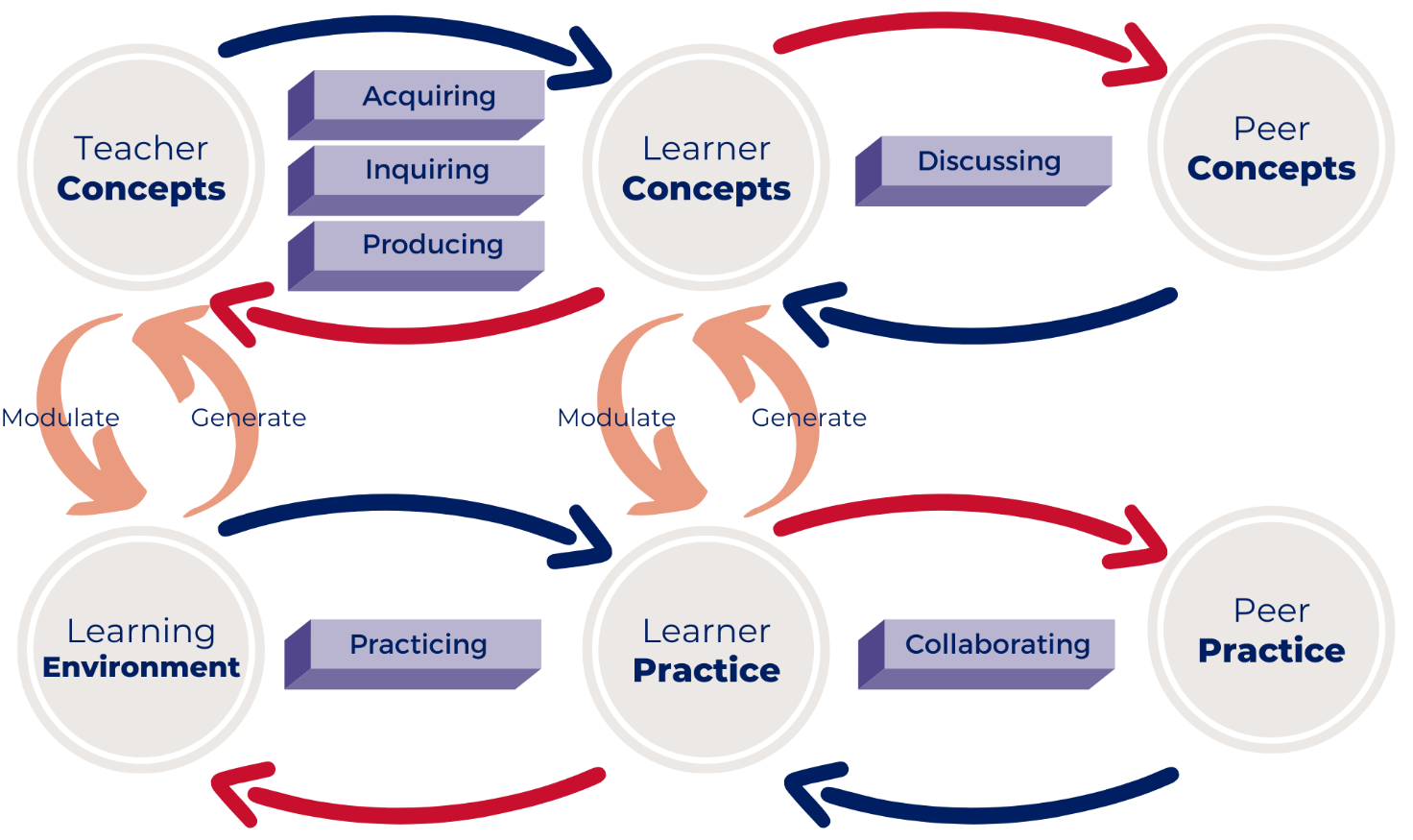Applying design frameworks for a new perspective on digital learning
Exploring the interconnection between technology and pedagogy to rethink teaching and learning
The global pandemic of COVID-19, among other causes, triggered an unprecedented digital revolution of the educational sector across the globe.. Educators from all continents started or intensified their experiments with digital technologies, while teaching online or in a hybrid format. After one year of this experimentation, testing and innovation, it is probably a time for educators to reflect on what they have learnt, share their findings and understanding what worked best.
Applying theoretically sound pedagogical models and frameworks could offer an effective way to support educators in this exercise. Conceptual frameworks are context-independent in the sense that they retain their basic meaning regardless of their applied context (Mayes & Freitas, 2004). They view learning as a meaning-making process where the teacher can focus on how to stimulate and support an exchange of knowledge representations and communications between individual learners, teachers and peers (Bruner, 1990; Perret-Clermont, Carugati, & Oates, 2004; Vygotsky, 1986).
By applying digital technologies, the process of meaning-making can be supported across the boundaries of time and space (Holmberg, 2017). This article considers Laurillard’s Conversational Framework (Laurillard , 2002) as a potential design framework rethinking our educational design supported by digital technologies.
The Conversational Framework
Laurillard’s Conversational Framework (CF) is a distillation of many theories of learning to support teachers in designing for learning. It provides an overarching theoretical design framework for thinking about how best to assist and encourage learning using technology to support meaning-making.

The CF places the individual learner at the centre and embraces six main types of learning, demonstrating how each of the cycles of iterative activity helps students develop their understanding between the concepts and their application in practice.
In formal education, learners can receive help from both the teacher and other learners. At the upper level of the framework depicts these interactions. and every interaction is an opportunity to develop their understanding of the concepts.
At the lower level, the teachers and students’ model and share their practice through actions and feedback in a special learning environment. And again, all those interactions are an opportunity to develop their skills in applying the concepts in practice. By integrating conceptual understanding and application in practice, the learner is able to maximise their opportunities for feedback, and ultimately, learning.
Which digital tools for which types of learning?
The table below suggests examples of digital tools that could work well with each learning type.
| Learning type | Examples of related digital tools |
| Acquisition | Publishing multimedia resources (video, audio, podcasts, recorded screen share with voiceover, etc) and PDF articles and case studies on Canvas.
Take a look at our guidance on Creating Content using Learning Technologies. |
| Collaboration | Small group projects; asking students to build a joint digital output (e.g. in PowerPoint); group task in Zoom breakout rooms to produce a joint document; group work using Mural. |
| Discussion | Creating Canvas discussions, word clouds using Mentimeter or Slido and asking students to comment. Asking students to discuss a topic in breakout rooms. |
| Inquiry/ Investigation | Suggesting a topic and asking students to look for examples and share via Mural, online discussion on Canvas, etc. |
| Practice | Business simulations (e.g. Case Studies available on LBS Publishing bespoke in HTML5/SCORM format), educational serious games and role-play activities. |
| Production | Asking students to produce digital documents (PowerPoint presentations, videos, blogs) on what they have leant, creating an e-portfolio. |
Online Learning Designer
Applying any framework can be a quite challenging exercise, especially at the start and even more so when workloads are incredibly high. To assist educators, the UCL Knowledge Lab developed the Learning Designer, a free, online learning design tool for teachers, enabling them to borrow, adapt, create and share their own learning designs, with a focus on transitioning online.
It is based on the Conversational Framework and builds on the six learning types so that the user can specify and evaluate the nature of the pedagogy that is designed for a session. One of the advantages of this tool is that it gives visual feedback on the design in terms of the nature of the learning experience it creates for students. Also, it is possible to prepare two versions of a session (conventional and online) and compare the two.
Building the community of knowledge for the digital tomorrow
Perhaps universality is one of the most important features of learning design. They can be shared across subject areas and even, to some extent, across education sectors. For a long time, teachers from primary schools to universities have shared the pedagogies: presentations, small group discussions, individual and group exercises, class discussions, assignments, etc.
This opens up an exciting future for the professional teaching community. Design tools like the Learning Designer make it possible for teachers across all subject areas to work together to develop an understanding of how to teach online effectively and support the digital transformation of education. There are hundreds of designs demonstrating the effective use of digital technologies already available on Learning Designer. Teachers can look for and adapt other people’s learning designs, helping to build and expand community knowledge.
The pandemic stimulated the unprecedented digital transformation of the educational sector with tens of millions of teachers across the globe experimenting, testing and innovating with learning technologies. This created a unique opportunity for building a teacher-led environment for sharing knowledge and experience, for learning from each other, and for shaping the future of education.
The use of tools to structure and visualise learning, such as Learning Designer, has the potential to significantly improve the effectiveness and efficiency of the design process, as well as to make it more open and inclusive.
References
Bruner, J., 1990. Acts of meaning. Cambridge: Harvard University Press.
Holmberg, J., 2017. Applying a conceptual design framework to study teachers' use of educational technology. Education and Information Technologies, Volume 22, pp. 2333-2349.
Laurillard , D., 2002. Rethinking University Teaching. A conversational framework for the effective use of learning technologies. London, UK: Routledge.
Laurillard, D., 2012. Rethinking University Teaching: A conversational framework for the effective use of learning technologies. London: Routledge Falmer.
Mayes, T. & de Freitas, S., 2004. Review of e-learning theories, frameworks and models. [Online]
Available at: http://www.jisc.ac.uk/whatwedo/programmes/elearningpedagogy/outcomes.aspx
Perret-Clermont, A.-N., Carugati, F., & Oates, J. (2004). A socio-cognitive perspective on learning and cognitive development. In J. Oates & A. Grayson (Eds.), Cognitive and language development in children (pp. 303–332). Milton Keynes/Oxford: The Open University & Blackwell Publishing.
Vygotsky, L. S. (1986). In A. Kozulin (Ed.), Thought and language. Cambridge: MIT Press.

